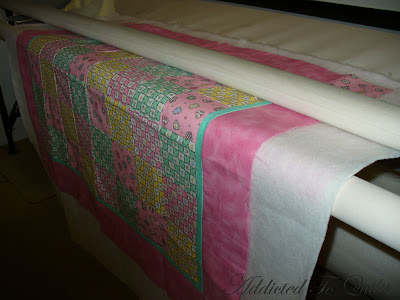Kathy asked in the comments of my previous post if I float my quilts. The answer is yes, and I thought I would share my method.
There are different ways of loading a quilt, and the best way depends on the preferences of the quilter. I prefer to float my quilt as I feel it gives me more control, and I am better able to see any issues as I am working through the quilt.
First I load the backing by pinning it to the rollers. I lay the wadding on the top of it, and then the quilt top, ensuring that the top is straight and square on the machine.
I then tack along the top edge of the quilt.
You can see in the picture that this quilt is extremely well pieced and is hanging straight on the machine. However if there were issues like a wavy border, or fullness in places, I would be able to clearly see it and be able to take steps to correct them.
These photos show the quilt on my A1 machine. Those with the same machine will see I have removed the top front roller. I don’t use this roller and found it got in my way.
I roll the quilt forward and tack down the sides.
After quilting or stabilising the available area, I roll the quilt forward, tacking down the sides as I go. I check to ensure the sides are straight as I tack them down. I also check that the lines in the piecing are straight and square.
I continue quilting, rolling the quilt forward and tacking down the sides until I get to the end of the quilt. Then I tack down the bottom of the quilt.
If you want to see this quilt completed – click here.
The above photos are on my A1 machine and I follow the same procedure on my APQS.
I haven’t removed the top roller on my APQS as it doesn’t get in the way like on the A1. I use it to line up the quilts to ensure they are square and it is handy to lean on.











